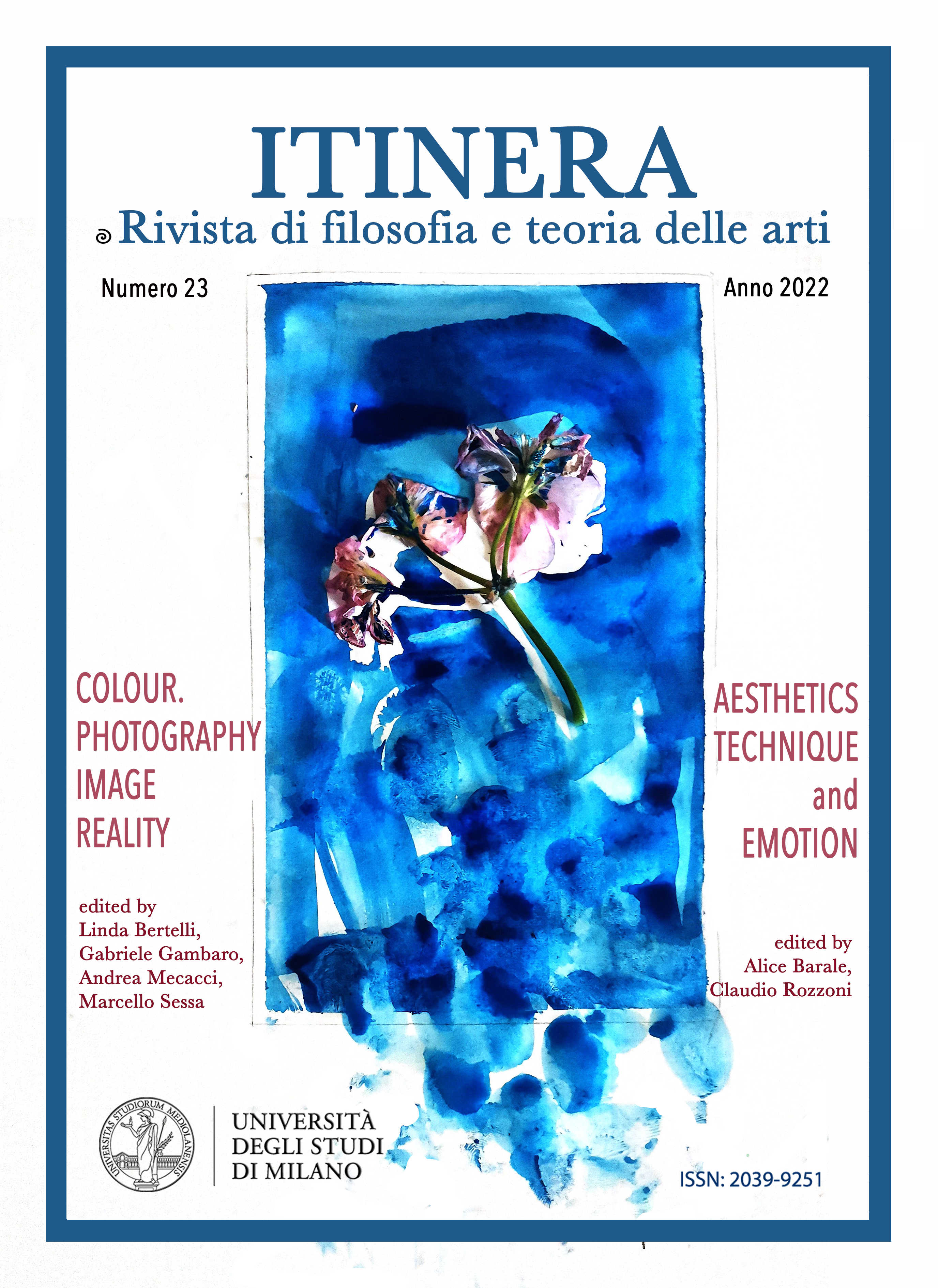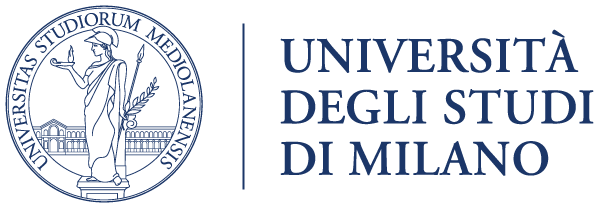The Carnal Specter: The Virtual Reality User Against Fragmentation
DOI:
https://doi.org/10.54103/2039-9251/18560Abstract
Since Virtual Reality (VR) is characterised by the absence of the frame, the VR user has the impression of being immersed into the image, thus overcoming the distinction between spectacle and spectator. Therefore, the user becomes herself part of the work of art, exposing the limits of the Cartesian dualisms dominating the Western thought and raising critical questions about traditional aesthetic categories. Hence, my paper aims at pondering on the ontological status of the VR user. In opposition to Simon Penny’s argument, which proposes that VR fragments the viewer into a physical body versus a virtual one, my research goal is to clarify that the participant’s physical body and virtual body are inseparable and firmly intertwined. In order to do so, I analyse the VR documentary Send me Home (Evanisko, 2019). The point of departure is the acknowledgment that the VR user is invisible both to herself and to the other characters with whom she shares the virtual space. Following Jacques Derrida’s Specters of Marx, I argue that this invisibility reveals the ontological status of the VR participant as a specter. However, my goal is to show that the spectrality of the user is not in contradiction with her carnality: on the contrary, even when one tries to bracket the body, the body remains vigilant, interpreting the world through its flesh. To conclude, then, I argue that the body is the condition of possibility for the user to feel immersed into the virtual world, and that, contrary to the fragmentation argument, physical body and virtual body cannot be thought as separate.
Riferimenti bibliografici
Barker, J. M., The Tactile Eye. Touch and the Cinematic Experience, University of California Press, Berkeley 2009.
Brown, T., Breaking the Fourth Wall: Direct Address in Cinema, Edinburgh University Press, Edinburgh 2012.
Casetti, F., Pinotti, A., Post-cinema Ecology, in D. Chateau and J. Moure, Post-cinema, Amsterdam University Press, Amsterdam 2020, pp. 193-217.
Charlton, J. M., and Moar, M., VR and the Dramatic Theatre: Are They Fellow Creatures?, in “International Journal of Performance Arts and Digital Media”, XIV/2, 2018, pp. 187-198.
Dalmasso, A. C., The Body as a Virtual Frame: Performativity of the Image in Immersive Environments, in “Cinéma & Cie”, XIX/32, 2019, pp. 101-119.
Derrida, J., and Stiegler, B., Spectographies, in M. del Pílar Blanco and E. Pereen (ed. by), The Spectralities Reader: Ghosts and Haunting in Contemporary Cultural Theory, Bloomsbury, London 2013, pp. 37-51.
Derrida, J., Specters of Marx: The State of the Debt, the Work of Mourning, and the New International, Routledge, New York 1994.
Fisken, T., The Spectral Proletariat: The Politics of Hauntology in The Communist Manifesto, in “Global Discourses”, II/2, 2011, pp. 17-31.
Friedberg, A., The Virtual Window. From Alberti to Microsoft, The MIT Press, Cambridge, MA and London, UK 2006.
Manovich, L., The Language of New Media, The MIT Press, Cambridge, MA and London, UK 2001.
Merleau-Ponty, M., Eye and Mind (1960), in M. Merleau-Ponty and J. Edie (ed. by), The Primacy of Perception and Other Essays on Phenomenological Psychology, the Philosophy of Art, History and Politics, Northwestern University Press, Evanston, IL 1964, pp. 159-190.
Merleau-Ponty, M., The Child’s Relations with Others (1960), in M. Merleau-Ponty and J. Edie (ed. by), The Primacy of Perception and Other Essays on Phenomenological Psychology, the Philosophy of Art, History and Politics, Northwestern University Press, Evanston, IL 1964, pp. 96-155.
Merleau-Ponty, M., The Visible and the Invisible (1964), ed. by C. Lefort, trans. by A. Lingis, Northwestern University Press, Evanston, IL 1968.
Modena, E., Pinotti A., Pirandello S., Virtual Reality and Augmented Reality. New Tools for Art and Politics, in “Paradigmi”, XXXIX/1, 2021, pp. 87-106.
Ortega y Gasset, J., Meditations on the Frame (1921), trans. by A. L. Bell, in “Perspecta”, XXVI, 1990, pp. 185-190.
Penny, S., Consumer Culture and the Technological Imperative: The Artist Dataspace, in S. Penny, Critical Issues in Electronic Media, State University of New York Press, New York 1995, pp. 47-73.
Rokem, F., Who’s There? Hamlet as Philosopher and Thespian, in F. Rokem, Philosophers & Thespians: Thinking Performance, Stanford University Press, Stanford 2010, pp. 59-86.
Schapiro, M., On Some Problems in the Semiotics of Visual Art: Field and Vehicle in Image-Signs, in “Simiolus: Netherlands Quarterly for the History of Art”, VI/1, 1972-3, pp. 9-19.
Shakespeare, W., Hamlet, in W. Shakespeare and W.J. Craig (ed. by), Shakespeare Complete Works, Oxford University Press, London 1996, pp. 870-907.
Sherman, W. R., and Craig, A. B., Understanding Virtual Reality. Interface, Application, and Design, Elsevier Science, San Francisco 2003.
Simmel, G., The Picture Frame: An Aesthetic Study, in “Theory, Culture, Society”, XI, 1994, pp. 11-17.
Sobchack, V., What my Fingers Knew: The Cinesthetic Subject, or Vision in the Flesh, in V. Sobchack, Carnal Thoughts: Embodiment and Moving Image Culture, University of California Press, Berkeley 2004, pp. 53-84.
Sobchack, V., The Address of the Eye. A Phenomenology of Film Experience, Princeton University Press, Princeton 1992.
Filmography
Carne y Arena, dir. Alejandro Iñárritu. Legendary Pictures, USA 2017.
Jackson, Rickey “Finding Freedom in an Art Museum” https://www.youtube.com/watch?time_continue=9&v=cCIhqDRQim4&feature=emb_title [last access: 19/06/2022].
Send me Home, dir. Cassandra Evanisko. Lonelyleap, USA 2019.
Dowloads
Pubblicato
Fascicolo
Sezione
Licenza
Gli autori che pubblicano su questa rivista accettano le seguenti condizioni:
1. Gli autori mantengono i diritti sulla loro opera e cedono alla rivista il diritto di prima pubblicazione dell'opera, contemporaneamente licenziata sotto una Licenza Creative Commons - Attribuzione - Condividi allo stesso modo 4.0 internazionale che permette ad altri di condividere l'opera indicando la paternità intellettuale e la prima pubblicazione su questa rivista.
2. Gli autori possono aderire ad altri accordi di licenza non esclusiva per la distribuzione della versione dell'opera pubblicata (es. depositarla in un archivio istituzionale o pubblicarla in una monografia), a patto di indicare che la prima pubblicazione è avvenuta su questa rivista.
3. Gli autori possono diffondere la loro opera online (es. in repository istituzionali o nel loro sito web) prima e durante il processo di submission, poiché può portare a scambi produttivi e aumentare le citazioni dell'opera pubblicata (Vedi The Effect of Open Access).





